Telehealth Continues to Show Success
 INDIANAPOLIS — Bryan Mills, CEO of the Community Health Network hospital system in Indiana, has been promoting the use of telehealth in hospitals for years. Telehealth, a system of using videoconferences and the Internet to administer medical attention, has started to become more prevalent in the modern-age of medicine.
INDIANAPOLIS — Bryan Mills, CEO of the Community Health Network hospital system in Indiana, has been promoting the use of telehealth in hospitals for years. Telehealth, a system of using videoconferences and the Internet to administer medical attention, has started to become more prevalent in the modern-age of medicine.
An Indianapolis-based health care service, Community Health Network, has been delivering mental health services online for many years already. They have mainly worked with smaller hospitals in their emergency departments where they are able to help mentally ill patients during a health crisis. He believes that telehealth, sometimes referred to as telemedicine, could work for patients who are suffering from a chronic illness such as diabetes, hypertension, asthma and mental illness, according to an interview gave to the Indianapolis Business Journal.
If telehealth continues to be successful, health care providers will be able to provide services and improve patient experience over the phone or videoconference, then the number of hospital stays and the amount of surgeries will decrease. If this occurs, hospital systems will no longer need new buildings to hold patients and provide services. “We believe that there’s a lot of things that we do that we could do virtually,” Mills said to the Indianapolis Business Journal.
Although telehealth is starting to be considered more as a viable option, in the past year, the health care construction related projects in Indiana have almost doubled, according to Revista, a Maryland-based market research firm.
According to the Indianapolis Business Journal, hospitals are becoming more comfortable with the changes made by Obamacare. The requirements to have health insurance and the aging population have brought more people to hospitals and into the health care system. The increase in patients has caused the hospitals to look for ways to handle the larger demand for health care and many health care systems are trying to use telehealth to decrease the amount of space needed for the patients. The Affordable Care Act has also encouraged facilities to see fewer patients, which makes telehealth an alternative for seeing patients.
A Los Angeles-based market research firm, IBISWorld has said that the revenue for telehealth will increase drastically, by almost 40 percent a year, through 2020 to revenue of $3.5 billion. “The industry has clearly hit a point where consumers are demanding it, employers see it as a cost savings, and insurers are more and more pushing it as a benefit. We think it’s going to grow tremendously,” said Ryan Daniels, analyst with William Blair & Co., in a statement.
On Oct. 8, the American Medical Association (AMA) announced that it will be encouraging digital medicine in clinical practices to adapt to the new telehealth system. They plan on having a sponsored group that will work with the practices to integrate the new technology in the Current Procedural Terminology (CPT) codes.
“Ensuring that CCPT codes accurately reflect the telehealth services provided to patients is only possible through the dedication and direct input of the advisors on the Telehealth Service Workgroup,” said AMA President Steven J. Stack, M.D., in a statement. “Tapping into the clinical and technological expertise of the health care community and innovators produces the practical enhancements that CPT needs to reflect the coding demands of the modern health care system.”
